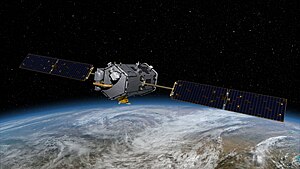 An artist rendition of the OCO satellite as it would look in orbit. | |
| Mission type | Climatology |
|---|---|
| Operator | NASA |
| Mission duration | Launch failure 2 years (planned) |
| Spacecraft properties | |
| Bus | LEOStar-2 |
| Manufacturer | Orbital Sciences[1] |
| Launch mass | 530 kg (1,170 lb)[1] |
| Payload mass | 150 kg (330 lb)[1] |
| Dimensions | Stowed: 2.3 × 1.4 m (7.5 × 4.6 ft)[1] |
| Power | 786 W [1] |
| Start of mission | |
| Launch date | 24 February 2009, 09:55:31 UTC[2] |
| Rocket | Taurus-XL 3110 (T8) |
| Launch site | Vandenberg, LC-576E |
| Contractor | Orbital Sciences |
| Orbital parameters | |
| Reference system | Geocentric |
| Regime | Sun-synchronous |

| |

The Orbiting Carbon Observatory (OCO) was a failed NASA satellite mission intended to provide global space-based observations of atmospheric carbon dioxide (CO2). The original spacecraft was lost in a launch failure on 24 February 2009, when the payload fairing of the Taurus rocket which was carrying it failed to separate during ascent.[3] The added mass of the fairing prevented the satellite from reaching orbit.[4] It subsequently re-entered the atmosphere and crashed into the Indian Ocean near Antarctica.[5][6] The replacement satellite, Orbiting Carbon Observatory-2, was launched 2 July 2014 aboard a Delta II rocket.[7][8] The Orbiting Carbon Observatory-3, a stand-alone payload built from the spare OCO-2 flight instrument, was installed on the International Space Station's Kibō Exposed Facility in May 2019.[9]
- ^ a b c d e Parkinson, Claire L.; Ward, Alan; King, Michael D., eds. (2006). "Orbiting Carbon Observatory" (PDF). Earth Science Reference Handbook. NASA. pp. 199–203. Retrieved 14 May 2015.
- ^ Overview of the Orbiting Carbon Observatory (OCO) Mishap Investigation Results For Public Release (PDF) (Report). NASA. Archived (PDF) from the original on 5 February 2022. Retrieved 5 November 2018.
- ^ Heiney, Anna (24 February 2009). "OCO Launch Coverage". NASA.
- ^ Brahic, Catherine (24 February 2009). "CO2-tracking satellite crashes after lift-off". New Scientist.
- ^ Minard, Anne (24 February 2009). "NASA Satellite Crashes Back to Earth". National Geographic News. Archived from the original on 25 February 2009. Retrieved 28 February 2009.
- ^ Achenbach, Joel; Eilperin, Juliet (25 February 2009). "Satellite Crashes After Its Launch". The Washington Post. Retrieved 28 February 2009.
- ^ "Homepage: Orbiting Carbon Observatory-2 (OCO-2)". NASA / Jet Propulsion Laboratory. 2013. Archived from the original on 22 February 2003. Retrieved 5 April 2014.
- ^ Rasmussen, Carol (2 April 2014). "NASA's OCO-2 brings sharp new focus on global carbon". NASA. Retrieved 4 November 2017.
- ^ "Orbiting Carbon Observatory 3: About the Mission". NASA. Retrieved 24 February 2019.